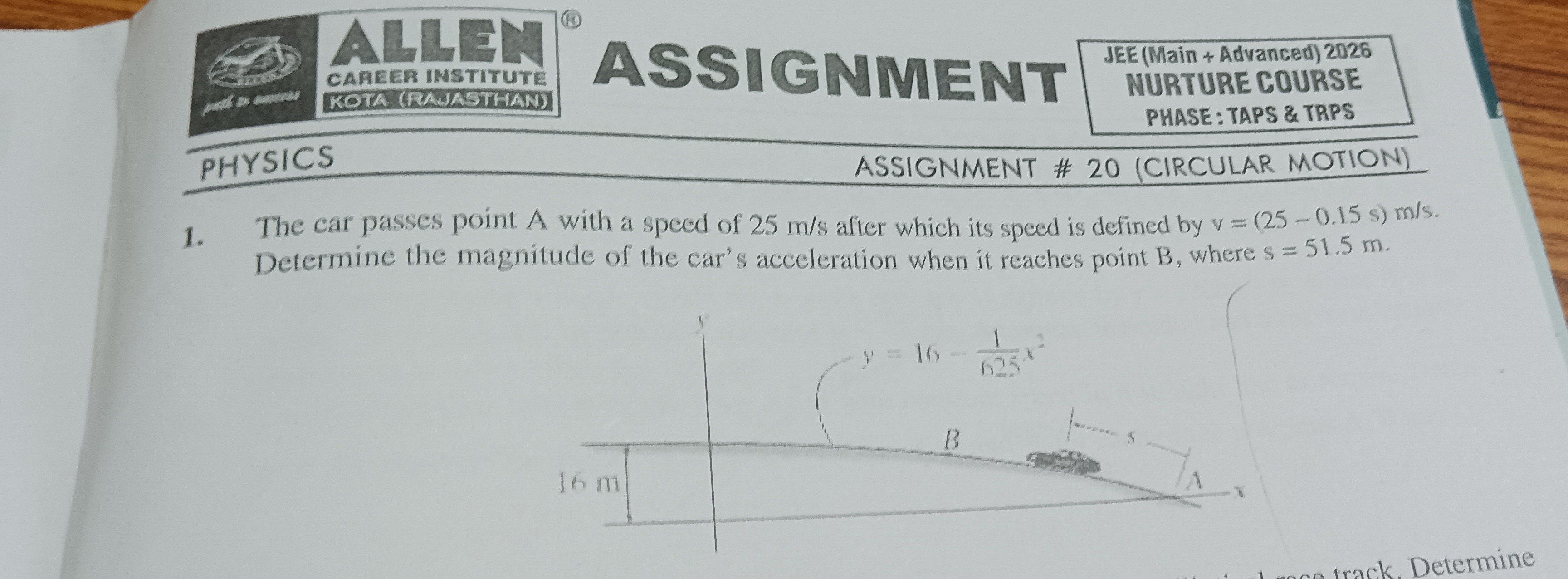Question
Question: The car passes point A with a speed of 25 m/s after which its speed is defined by v = (25 - 0.15 s) ...
The car passes point A with a speed of 25 m/s after which its speed is defined by v = (25 - 0.15 s) m/s. Determine the magnitude of the car's acceleration when it reaches point B, where s = 51.5 m.

2.75 m/s^2
Solution
The car's motion involves both a change in speed (tangential acceleration) and a change in direction (normal acceleration). The total acceleration is the vector sum of these two components.
1. Calculate Tangential Acceleration (at): The speed of the car is given by v=(25−0.15s) m/s. Tangential acceleration is the rate of change of speed, at=dtdv. Since v is a function of s, we use the chain rule: at=dsdvdtds=dsdvv.
First, find dsdv: v=25−0.15s dsdv=−0.15 s−1.
Next, calculate the speed v at point B, where s=51.5 m: vB=25−0.15(51.5) vB=25−7.725 vB=17.275 m/s.
Now, calculate the tangential acceleration at at point B: at=(−0.15)×(17.275) at=−2.59125 m/s2. The negative sign indicates deceleration. The magnitude of tangential acceleration is ∣at∣=2.59125 m/s2.
2. Calculate Normal Acceleration (an): Normal acceleration is given by an=ρv2, where ρ is the radius of curvature of the path at point B. The path is defined by the equation y=16−6251x2. To find the radius of curvature ρ, we need the first and second derivatives of y with respect to x: y′=dxdy=−6252x y′′=dx2d2y=−6252
The formula for the radius of curvature is ρ=∣y′′∣[1+(y′)2]3/2.
We need to find the x-coordinate of point B corresponding to an arc length s=51.5 m from point A (the vertex at x=0). The arc length s from x=0 to x is given by s=∫0x1+(y′)2dx. s=∫0x1+(−6252t)2dt=∫0x1+62524t2dt. This integral is difficult to solve analytically for x. However, for small values of y′, we can use the approximation 1+u≈1+21u. So, 1+62524t2≈1+21(62524t2)=1+62522t2. Using this approximation: s≈∫0x(1+62522t2)dt=[t+3×62522t3]0x=x+3×62522x3. Given s=51.5 m: 51.5=x+3×(625)22x3 51.5=x+3×3906252x3=x+11718752x3. Let's find x by trial and error or by checking close values: If x=51.25: 51.25+11718752(51.25)3=51.25+11718752(134673.828)=51.25+1171875269347.656≈51.25+0.2298≈51.4798. This is very close to 51.5. So we can use x≈51.25 m as the x-coordinate for point B.
Now, calculate y′ at x=51.25 m: y′=−6252(51.25)=−625102.5=−0.164.
Now, calculate the radius of curvature ρ at point B: ρ=∣−6252∣[1+(−0.164)2]3/2=6252[1+0.026896]3/2 ρ=0.0032(1.026896)3/2=0.00321.04046≈325.14 m.
Finally, calculate the normal acceleration an at point B: an=ρvB2=325.14(17.275)2 an=325.14298.425625≈0.9178 m/s2.
3. Calculate the Magnitude of Total Acceleration (a): The magnitude of the total acceleration is a=at2+an2. a=(−2.59125)2+(0.9178)2 a=6.7145+0.8423 a=7.5568 a≈2.749 m/s2.
Rounding to a reasonable number of significant figures, the magnitude of the car's acceleration is approximately 2.75 m/s2.
